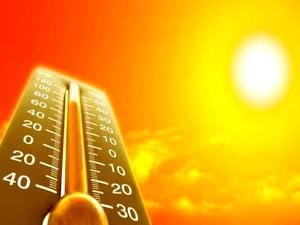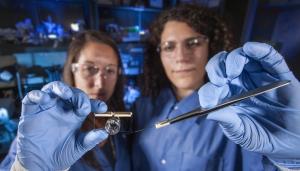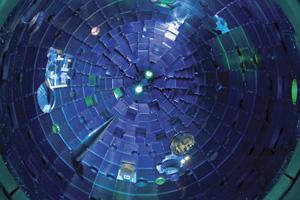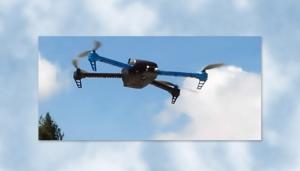LAB REPORT
Science and Technology Making Headlines
July 20, 2018


Lawrence Livermore scientists have found that mid-latitude regions of Northern Hemisphere continents have a large seasonal cycle of atmospheric temperature, with frigid winters and hot summers. Satellite temperature data are consistent with models that project that this seasonal ‘heartbeat’ is becoming stronger with human emissions of carbon dioxide.
The reason for the seasons
Humans are altering seasonal climate cycles worldwide, according to a new study by Lawrence Livermore National Laboratory.
An analysis of decades of satellite data has revealed how humans are changing seasonal cycles in the lower atmosphere. The accumulation of greenhouse gases produced by burning fossil fuels has increased air temperatures in summer and caused larger annual temperature swings in the Northern Hemisphere.
Previous research has documented how global warming is altering seasons on the ground — causing winter snowpacks to melt earlier, shifting animal migrations and lengthening fire seasons. The latest study, which draws on satellite temperature records from 1979 to 2016, is the first to pinpoint seasonal changes in the atmosphere. The odds that natural climate variability can account for the magnitude of the temperature changes over the course of the satellite record are roughly five in a million.
“In the biological world, lots of people have been looking for and finding these changes, so we decided to take a look at the satellite data,” says lead author Benjamin Santer, an LLNL atmospheric scientist. “What we see is profound evidence of the human impact on climate, not only in the annual temperatures but also in the seasonal cycle.”


Heat waves in California will be more common in the future.
It’s getting hot, hot, hot
The heat waves that have hit all of California are turning into the new norm.
Ben Santer, a climate scientist with Lawrence Livermore National Laboratory, knows something about this. “This isn’t a big scientific surprise,” he said about the prevalence of longer and more frequent heat waves. That’s a key marker of changes caused by the burning of fossil fuels, he said, as is the fact that nighttime temperatures are rising significantly, and record-setting hot days outnumber record-setting low temperatures by a 5 to 1 ratio.
Santer said he recently took a grueling hike in sweltering heat last weekend in an east San Francisco Bay park, trying to pump his stamina for a coming trip to the Juneau Icefield Research Program, where students study the melting of the ice cap as greenhouse gases warm the planet. Santer said that last summer, Northern California experienced an extended heat wave that was unlike anything he had experienced in his 28 years of living there.
His specialty is to do what’s known as climate change fingerprinting. In other words, for those who claim there’s no such thing as global warming, he presents evidence to the contrary.


Lawrence Livermore National Laboratory scientists compared drug responses in the brains of rodents to drug responses of brain cells cultured in Lab-developed “brain-on-a-chip” devices. Photo by Randy Wong/LLNL
Chipping away at organs
A new study in which Lawrence Livermore scientists compared drug responses in the brains of rodents to drug responses of brain cells cultured in Lab-developed “brain-on-a-chip” devices, may be a critical first step to validating chip-based brain platforms.
LLNL scientists gave freely moving rodents two different drugs, atropine and ketamine, and recorded their neural activity using LLNL-fabricated multielectrode arrays implanted in their brains. They compared the neuronal spiking and bursting patterns with data gathered from LLNL’s brain-on-a-chip device, an in vitro (outside of the body/organism) platform consisting of purified rat neurons cultured on a multielectrode array, developed as an alternative to human testing of pharmaceutical drugs or chemical agents.
Researchers cautioned the study isn’t a comprehensive validation, but rather an important initial step toward a more thorough comparison between in vivo (inside of the body/organism) and in vitro responses.


NIF’s target chamber is where the magic happens -- temperatures of 100 million degrees and pressures extreme enough to compress the target to densities up to 100 times that of lead are created there. Photo by Jason Laurea/LLNL
A smashing new record
The 192-beam laser at the National Ignition Facility (NIF) has set a new energy record, delivering a 2.15 megajoules (MJ) pulse to its target chamber.
Officials at Lawrence Livermore, where the giant system is located, say that represents more than a 10 percent increase on the previous best of 1.9 MJ -- a milestone set back in March 2012.
This demonstration shot successfully meets a National Nuclear Security Administration Level 2 milestone for 2018 and could see NIF operate at substantially higher energies in the future -- and well beyond the original design specification of 1.8 MJ.


Lawrence Livermore researchers flew test campaigns with two commercial drones and developed an estimate of the energy needed to deliver a package in various scenarios. They also considered how battery technology and drone design will improve over time.
Droning on about delivery
Most of the 1 million drones registered in the United States are used for fun, but a growing number are used commercially. Companies like Amazon, UPS and Google already are exploring ways to deliver packages with drones instead of trucks.
In research by Lawrence Livermore National Laboratory, scientists found that in some cases using electric-powered drones rather than diesel-powered trucks or vans could reduce energy use and greenhouse gas emissions. But in other cases, using trucks -- especially electric-powered ones -- would be more efficient and cleaner.
Reducing the need for trucking by delivering some packages with electric drones could save fuel, and potentially carbon emissions. The team modeled how much energy drone delivery would use, and how it would be different from the ways packages are delivered now.





